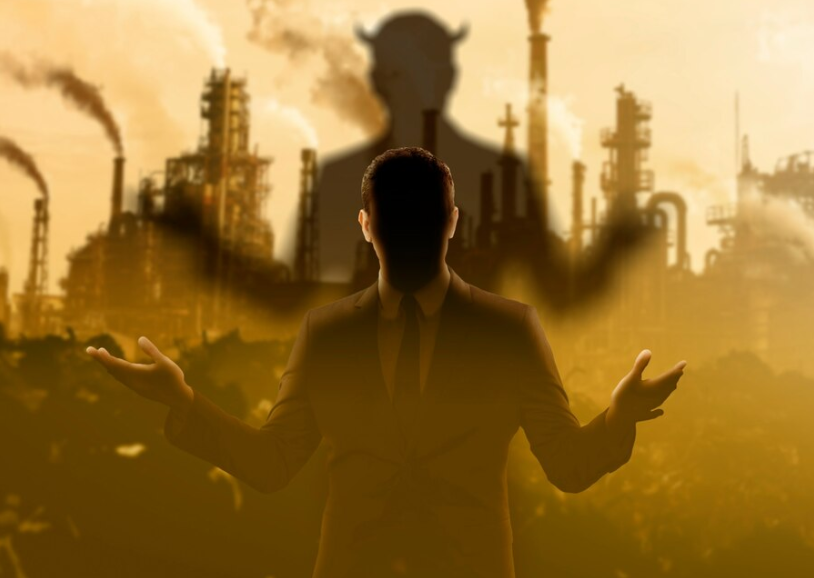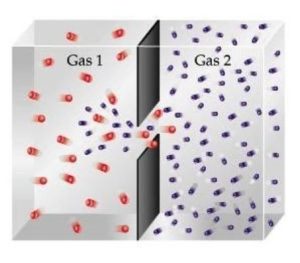Real Gases vs. Ideal Gases
While the Kinetic Molecular Theory (KMT) gives us an idealized model of gas behavior, real gases deviate from these ideal behaviors under certain conditions.
When do gases deviate from the Ideal Gas Law?
Low temperatures and high pressures are when gases deviate most from the Ideal Gas Law. Here’s why:
Gas particles can become attracted to each other:
- At low temperatures, gas particles move slower, and intermolecular forces (IMFs) become more significant as they spend more time near each other. This violates the KMT assumption that there are no attractive or repulsive forces between particles.
- Polar molecules or larger molecules exhibit stronger IMFs, causing them to behave less ideally than small, non-polar gases like H₂ or He.
- Real gases have lower pressure than ideal gases because the attractive forces between particles prevent them from hitting the walls of the container as often.
Gas particles make up a significant portion of a gas sample’s volume:
- At high pressure, the volume of the gas particles themselves becomes significant. According to Boyle’s Law, as volume decreases, gas particles take up more space and the volume no longer follows the ideal gas assumption.
- Real gases have a higher volume than predicted by the Ideal Gas Law because the volume of the particles is no longer negligible.

Graphically Representing Deviations:
On a graph comparing PV/RT to pressure, real gases deviate from ideal behavior as pressure increases. For an ideal gas, PV/RT = 1, but real gases deviate from this value, as shown in the graph below:
Image: Graph of gas deviation from ideal gas behavior
Graph showing deviation from ideal gas law at high pressure.

Correcting the Ideal Gas Law: The Van der Waals Equation
The Van der Waals equation adjusts for the non-ideal behavior of gases by adding corrections to the pressure and volume terms in the Ideal Gas Law:
- corrects for the intermolecular forces (adjusts pressure).
- corrects for the finite volume of gas particles.
Key Concept: You do not need to use or memorize this equation for AP Chemistry. Just understand that it corrects for deviations at high pressures and low temperatures.
Practice Question: Real Gases
Let’s go over an FRQ from the 2019 AP Chemistry exam:
Question: The student measures the actual pressure of CO₂(g) in the container at 425 K and observes that it is lower than the pressure predicted by the Ideal Gas Law. Explain this observation.
Sample Response: The attractive forces between CO₂(g) molecules result in a pressure that is lower than predicted by the Ideal Gas Law. Since the particles are attracted to each other, they do not collide with the walls of the container as often as ideal gases without attractive forces would.
Diffusion and Effusion
Diffusion
Diffusion describes the mixing of gases. There are two important trends to remember:
- As temperature increases, the rate of diffusion increases because particles move faster.
- Larger molecules diffuse more slowly because they have greater mass and move slower.
Effusion
Effusion is similar to diffusion, but it describes the passage of gas particles through a tiny opening into a vacuum. Gases flow from high pressure to low pressure through a pinhole.
Key trends for effusion:
- Higher temperature increases the rate of effusion.
- Larger molar mass decreases the rate of effusion.

Graham’s Law of Effusion
Graham’s Law provides a relationship between the rates of effusion of two gases:
Where:
- and represent the rates of effusion of two different gases.
- and represent the molar masses of the two gases.
Application of Graham’s Law:
Graham’s Law tells us that lighter gases effuse faster than heavier gases. The rate of effusion is inversely proportional to the square root of the gas’s molar mass.
Summary of Key Concepts:
- Real gases deviate from ideal behavior at low temperatures and high pressures.
- The Van der Waals equation corrects for real gas behavior, accounting for attractive forces and the finite volume of gas particles.
- Diffusion refers to gas mixing, while effusion refers to gas movement through a tiny opening.
- Graham’s Law relates the rate of effusion to the molar mass of gases—lighter gases effuse faster.









